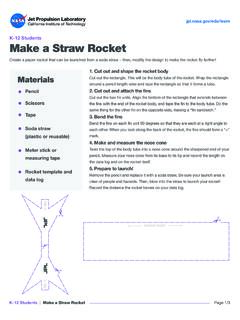Transcription of Exploring Exoplanets with Kepler - Jet Propulsion Laboratory
1 Exploring Exoplanets with Kepler : WORKSHEET NASA/JPL Education Exploring Exoplanets with Kepler Discover more: Kepler 's Third Law states: The square of the orbital period of a planet is directly proportional to the cube of the semi-major axis of its orbit (or the average distance to the sun). For our solar system and planets around stars with the same mass as our sun, that simply states that R3 = T2, where R is a planet's distance from the sun in Astronomical Units (AU) and T is the planet's orbital period in years. Because the distance between earth and the sun (1 AU) is 149,600,000 km and one earth year is 365 days, the distance and orbital period of other planets can be calculated when only one variable is known. Kepler s Third Law to calculate the missing data for these planets inour solar planets around other stars ( Exoplanets ), we must modify the formula to account for the variation in the star s mass as compared with our sun.
2 So we use R =T ! M!!where Ms = is the star s mass in relation to our sun's mass. Kepler s Third Law and the light curve data below to calculate themissing data for Kepler -5b, 6b, 7b and 8b. Then, calculate the missinginformation for Kepler -452b, the most earth -like exoplanet yet FACT: Stars observed by the Kepler mission with confirmed Exoplanets are named Kepler -1, Kepler -2, Kepler -3, etc. The Exoplanets around these stars are given a letter that corresponds to the order in which they were discovered, starting with b. So, Kepler -5b is the first exoplanet discovered around the fifth star found to have a planet. Planet Orbital Period (years) Orbital Period (days) Distance from Sun (AU) Distance from Sun (km) Mercury AU Venus days earth 1 year 1 AU Planet Mass of Parent Star (relative to sun) Orbital Period (days) Distance from Parent Star (AU) Distance from Parent Star (km) Kepler -5b AU Kepler -6b Ms Kepler -7b 9,350,000 km Kepler -8b Ms Kepler -452b Ms 156,500,000 km Exploring Exoplanets with Kepler : WORKSHEET NASA/JPL Education Exploring Exoplanets with Kepler Discover more.

















